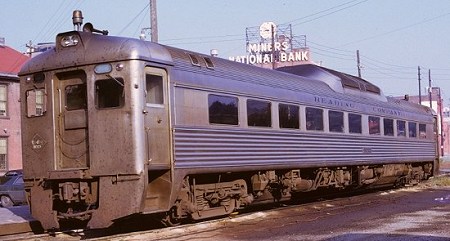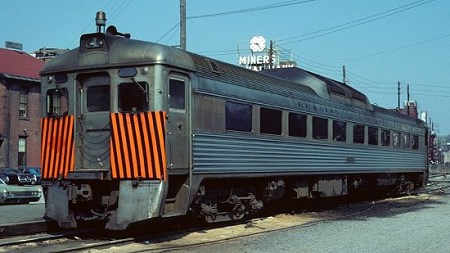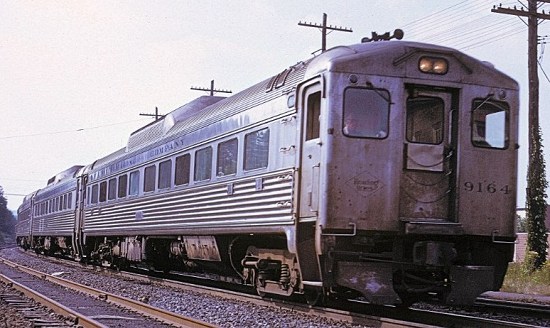Budd: Rail Diesel Car (RDC)

 The first twelve RDCs, numbered 9151 through 9162, were assigned the class RDB-13 (Rail Diesel, Budd, Multiple-Unit, Cab Signals) and entered into service in the latter part of 1962. The units were serviced from Wayne Junction and Saucon Creek, which allowed the Reading to close the long-operating Green Street engine facility. This group of RDCs were all "RDC-1" models, which were "full passenger" units. The Reading's units were unique in that the end windows were enlarged for greater visibility in response to complaints from the Brotherhood of Locomotive Engineers. Upon entry into service, the RDCs operated on Bethlehem Branch and Main Line trains as well as some of the other Philadelphia area commuter lines, where they operated both singly and in multiple-unit configuration.
The first twelve RDCs, numbered 9151 through 9162, were assigned the class RDB-13 (Rail Diesel, Budd, Multiple-Unit, Cab Signals) and entered into service in the latter part of 1962. The units were serviced from Wayne Junction and Saucon Creek, which allowed the Reading to close the long-operating Green Street engine facility. This group of RDCs were all "RDC-1" models, which were "full passenger" units. The Reading's units were unique in that the end windows were enlarged for greater visibility in response to complaints from the Brotherhood of Locomotive Engineers. Upon entry into service, the RDCs operated on Bethlehem Branch and Main Line trains as well as some of the other Philadelphia area commuter lines, where they operated both singly and in multiple-unit configuration. The operation of the initial group of RDCs proved to be a success, as the Reading went on the hunt for additional units a few years later, purchasing 4 additional cars - #9163 was acquired from the Lehigh Valley, while #9164 through #9166 were obtained from the Boston and Maine. #9165 was an RDC-2 model, which included a baggage section, and #9166 was an RDC-3, which had both a baggage section and an RPO compartment. Since the baggage and RPO sections on these two cars were no longer required, the Reading converted them to snack bars and placed them into service on the Crusader and Wall Street trains. The RDCs continued to serve the Reading until 1974, when all passenger service was transferred to SEPTA. SEPTA continued to operate the RDCs until 1981, when all non-electrified service ended.
The operation of the initial group of RDCs proved to be a success, as the Reading went on the hunt for additional units a few years later, purchasing 4 additional cars - #9163 was acquired from the Lehigh Valley, while #9164 through #9166 were obtained from the Boston and Maine. #9165 was an RDC-2 model, which included a baggage section, and #9166 was an RDC-3, which had both a baggage section and an RPO compartment. Since the baggage and RPO sections on these two cars were no longer required, the Reading converted them to snack bars and placed them into service on the Crusader and Wall Street trains. The RDCs continued to serve the Reading until 1974, when all passenger service was transferred to SEPTA. SEPTA continued to operate the RDCs until 1981, when all non-electrified service ended.
MODELING NOTES: There are a few models of RDCs available in various scales; however, some of these units have poor-quality drive mechanisms and would need to be upgraded for reliable operation. Cosmetically, there were not many non-standard modifications - as noted in the text, you could enlarge the end windows to 23 1/4" by 25 3/8". Reading diamonds were placed on the ends. The initial batch, 9151 through 9162, had cast diamonds, while they were painted on the RDCs acquired second-hand. In 1974, the Reading added orange and black end stripes and a flashing strobe light to some RDCs for safety, work from a prototype photo for accurate painting and lettering. Operationally, the RDCs would be most appropriate on the Main Line, Bethlehem and New York branches.
Did You Know?
Downloads
 A variety of Reading Company operations related documents, etc. that may be of use in your modeling efforts.
A variety of Reading Company operations related documents, etc. that may be of use in your modeling efforts.
 A variety of Reading Company operations paperwork, such as train orders, clearance forms, etc. that will help you operate your Reading layout in a prototypical manner.
A variety of Reading Company operations paperwork, such as train orders, clearance forms, etc. that will help you operate your Reading layout in a prototypical manner.
 Public Timetables, Employe Timetables, and Rulebooks that provide much useful operational information.
Public Timetables, Employe Timetables, and Rulebooks that provide much useful operational information.
 Signs, billboards, and other FREE goodies for your use. We ask only that you help spread the word about The Reading Modeler!
Signs, billboards, and other FREE goodies for your use. We ask only that you help spread the word about The Reading Modeler!

